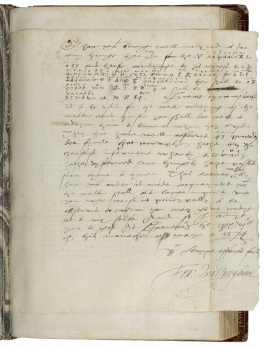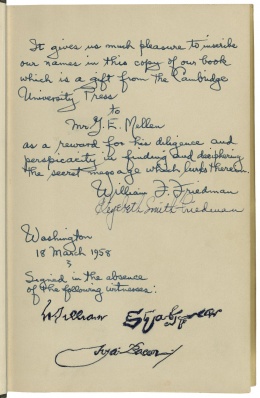Decoding the Renaissance: 500 Years of Codes and Ciphers

Decoding the Renaissance: 500 Years of Codes and Ciphers, one of the Exhibitions at the Folger, opened November 11, 2014 and closed February 26, 2015. Decoding the Renaissance was curated by Bill Sherman, Head of Research at the Victoria and Albert Museum and Professor of Renaissance Studies at the University of York with assistance from Ron Bogdan, Senior Cataloger at the Folger Shakespeare Library.
The Renaissance was the first great age of mass communication, but it was also the period when the art of secret writing came into its own. The new science of codes and ciphers produced some of the period’s most brilliant inventions, most beautiful books, and most enduring legacies. It left its mark on virtually every aspect of Renaissance culture, including the development of diplomacy and the waging of war, the creation of a postal system, the invention of sign language, and the search for hidden meanings in literature and the visual arts. The Renaissance, in turn, provided the inspiration for the pioneering modern code-breaker,William F. Friedman—chief cryptanalyst for the U.S. government from the 1920s to the 1950s and regular researcher at the Folger.
Friedman led the team that broke the Japanese code in World War II, wrote many of the field’s foundational texts, and coined the very term “cryptanalysis” for the study of secret writing systems. His introduction to ciphers (as well as to his wife Elizebeth, a distinguished code-breaker in her own right) came through his early work on Sir Francis Bacon, and he drew directly on Renaissance techniques throughout his cryptographic career—many of them learned from the books in this room. Decoding the Renaissance will take you on a tour of some five hundred years of secret communication in the company of the country’s first cryptographic couple, revealing the surprising connections between Renaissance texts and modern methods of cryptanalysis.
Curation
Decoding the Renaissance was curated by Bill Sherman with assistance from Ron Bogdan.
Bill Sherman is Professor of English at the University of York. He has held visiting positions at Caltech and Queen Mary (University of London) and fellowships at the Folger, Huntington, New York Public Library, and National Maritime Museum. Best known for his work on the history of books and readers, Sherman has also written on the early literature of travel, the theory and practice of editing, and the history of espionage.
He spends as much time as possible digging around in old archives in pursuit of overlooked texts, forgotten objects, and covert actions of various kinds: recent discoveries include Bernardo Bembo's long-lost copy of the letters of Pliny the Younger (the classical model for the country villas built by Bembo and his fellow humanists) and an unpublished book on ciphers by William Friedman (who got his start studying Shakespeare and Bacon and ended up as the most important code-breaker in American history). Sherman's recent publications include Used Books: Marking Readers in Renaissance England and editions of Shakespeare's Tempest and Jonson's Alchemist; and he is currently working on an edition of Marlowe's The Jew of Malta, a book on The Reader's Eye, and a study of Renaissance cryptography.
Curator's insights

One of curator Bill Sherman's favorite items in Decoding the Renaissance: 500 Years of Codes and Ciphers is a light-hearted drawing of an imaginary plant, created in 1916 in his spare time by a young plant geneticist (soon to become a leading US cryptographer) named William Friedman. "It's mind-blowingly clever, and fun," Sherman says.
Using a cipher devised by Francis Bacon in the late 1500s, Friedman packed his drawing from petals to roots with hidden messages—all explained in neat, hand-lettered captions. This Renaissance-inflected drawing "is William Friedman's earliest known work," Sherman says. "A few years later, he's writing the foundational text in modern American cryptography."
Such connections between Renaissance and twentieth-century cryptography are a major theme of the exhibition. They reflect, says Sherman, "the big surprise in this field; almost everything in modern cryptography comes from the Renaissance, in a way that isn't true of other fields. In other fields, we may think of Renaissance sources as crude, primitive, or superstitious—not so here. The Renaissance principles of cryptography are still its guiding principles in the 20th century."
For Sherman, William Friedman and his wife Elizebeth, another gifted cryptographer, are the exhibition's "go betweens" connecting the sixteenth and twentieth centuries. "It's not only exhibiting the SIGABA machine," Sherman says, referring to a top-secret World War II cipher machine that William Friedman invented. "It's putting it next to Alberti's cipher wheel from the 1460s."
Decoding the Renaissance is also thought to be the first large introductory exhibition ever on Renaissance cryptography, drawing together numerous rare books and other materials from the Folger and Library of Congress collections. "We've managed to bring into one room all of the pioneering works in the field," Sherman says. "It's incredibly exciting." Cryptography was included in almost every aspect of life in the Renaissance, he says. "Today, we think of cryptography as related to the military, or to mathematics. In the fourteenth, fifteenth, and sixteenth centuries, it's everywhere."
Another artifact bridging the centuries—and the highlight of the exhibition—is the fifteenth-century Voynich Manuscript, rediscovered in 1912, which has been called the most mysterious manuscript in the world. "At one end of the exhibition hall we have the first two printed books on cryptography," says Sherman, "At the other end, the Voynich Manuscript."
Still unread, the manuscript "has been primarily approached by cryptographers as a problem of code, from 1912 to the present," Sherman says. William Friedman was fascinated by the manuscript and led three different teams in trying, unsuccessfully, to solve it. "In a show about Renaissance codes and ciphers, with William Friedman, the Voynich Manuscript had to be there."
As for exhibition visitors pondering both that mystery and the wealth of early works on codes and ciphers, Sherman believes the takeaway message is simple, but profound: "Without going crazy," he says, "there's often more than meets the eye. Text or image may not be what it seems to be. A flower might be a code. It's a powerful insight," he says, "and quite a dangerous one."
As for the ciphers, codes, and other Renaissance-originated methods that make that possible, he acknowledges that they may sometimes "hurt people's brains—but in a good way." At their best, he says, Renaissance and modern cryptography "are like when you try a hard crossword puzzle—or see a really good magic trick."
Contents of the exhibition
Decoding the Renaissance explores some five hundred years of secret communication, introducing the tricks of the trade and revealing the surprising connections between Renaissance texts and technologies and modern methods of cryptanalysis. The exhibition brings together all of the key Renaissance texts on cryptography, many of William and Elizebeth Friedman’s most influential works, and the most mysterious of all unbroken codes, the so-called Voynich Manuscript, on loan for the first time from the Beinecke Library at Yale.
Decoding the Renaissance exhibition material
This article offers a comprehensive and descriptive list of each piece included in the exhibition and is arranged into three zones: The Renaissance of Cryptography; How To Make Anything Signify Anything; and Enigmas and Machines.
See also, Decoding the Renaissance exhibition item list for more information.
Supplemental materials
Audio
Rebecca Sheir, host of the Folger's Shakespeare Unlimited series, talks with curator Bill Sherman about codes and ciphers from the renaissance to today.
Video
An elaborate manuscript written in an unknown language: what can it mean? Exhibition curator Bill Sherman suggests that "it's the mysteries that teach you." We may never know what the Voynich Manuscript says but considering why it was made may be the more interesting question.
William Friedman, the father of modern American cryptography, broke the Japanese code PURPLE which helped lead to victory in World War II. Curator Bill Sherman explains that Friedman's study of Sir Francis Bacon's 16th century biliteral cipher and the search for hidden codes in Shakespeare (none were found) were essential parts of his training as a codemaker - and code breaker.
In the News
Renaissance Codes and Ciphers Exhibition at the Folger, by Barbara Basbanes Richter, November 14, 2014, for Fine Books & Collections blog.
The mysterious Voynich Manuscript highlights Folger Shakespeare Library’s ‘Decoding the Renaissance: 500 Years of Codes and Ciphers’ by Sadie Dingfelder, November 20, 2014, in The Washington Post.
Cracking Codes Through the Centuries, by William Grimes, February 3, 2015, for The New York Times.
Related programs
Talks and Screenings at the Folger
- Public Panel: The Voynich Manuscript, Bill Sherman and René Zandbergen, November 11, 2014
- "The Secret Writings of Mary Queen of Scots", Carol Ann Lloyd-Stanger, February 13, 2015
Folger Theatre
- William Shakespeare's Julius Caesar, October 28 – December 7, 2015
- Friedrich Schiller's Mary Stuart, January 27 – March 8, 2015